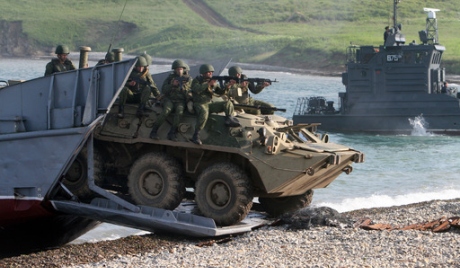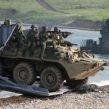
“Virtual” Defense of the Russian Far East: Vostok 2010
Publication: Eurasia Daily Monitor Volume: 7 Issue: 129
By:

The biennial Vostok (East) 2010 operational-strategic exercise in the Siberian and Far East Russian military districts (MD’s), June 28 to July 8, was hailed by the top brass as the largest of its kind since the collapse of the Soviet Union. Defense ministry sources indicated the exercise would involve 20,000 servicemen, 70 aircraft, 30 ships, and up to 2,500 pieces of equipment (Vedomosti, June 30). This exercise is significantly larger in scope and geographical coverage than Vostok 2008, (July 26-August 1, 2008) which featured 8,000 servicemen and more than 650 units of equipment, focused on securing the transportation of hydrocarbons in the Siberian Federal District and the prevention of terrorism against merchant shipping and key installations (Interfax, July 28, 2008).
It is a key test for the “new look” Russian armed forces, testing the speed of deploying the brigades formed in 2009 and attempts to correct shortcomings exposed by previous exercises. Vostok 2010, commanded by Army-General Nikolai Makarov, the Chief of the General Staff, in its scope and aims offers practical insight into the level of progress amongst the reformed structures, opportunity for further fine tuning as well as drawing attention to the weakness of the Russian Far East in the face of the relentless rise of China and growing concern among the Russian security elites about the strength of the People’s Liberation Army (PLA). Officially, the top brass offer multiple explanations on the precise nature of the scenario, ranging from anti-piracy, to counter-terrorism, while Makarov strenuously denied that it was aimed against “any one country or bloc” (Interfax, June 29).
On July 3, the Russian defense ministry reported that the air force and air defense formations in the Siberian and Far East MD’s had accomplished their missions. MiG-31 fighter-inceptors and Su-27 fighters flew from temporary and permanent air bases, with pilots launching live missiles over the Telemba range in Chita. Air-defense forces carried out live launches of S-300 anti-aircraft missile systems against Korshun and Strizh targets. Su-24’s and Su-25’s were used to simulate an enemy air raid. Su-34 fighter-bombers, A-50 early warning aircraft and An-12’s were used. A squadron of “blue” bombers rehearsed crossing the state border with their mission to bomb the Russian Far East capital, Khabarovsk, successfully detected by “red” radars before their interception. Valeriy Shcheblanin, spokesman for the commander of the Siberian MD, said the exercise involved a “completely new, single, integrated control system of anti-aircraft missile troops and ground forces air defense” used there for the first time, adding, “Computer modeling and digital situational analysis and assessment systems are being actively used,” which he illustrated by referring to “automated command and control systems” and video conferences (Interfax, July 3).
Automated command and control systems (developed by Voronezh Sozvezdiye) and computer modeling facilitated decision making and coordinating armed forces units with those from other security structures, including the Federal Security Service (FSB), interior ministry and FSB Border Guards. Two motor rifle brigades were tasked with completing marches in unfamiliar territory and their combat mission was to “localize and eliminate a domestic armed conflict on Russian territory” (Krasnaya Zvezda, July 2).
Vostok 2010 was also utilized experimentally to examine the planned merger of rear services with the armaments directorate in order to eliminate duplication. According to Colonel-General Dmitry Bulgakov, Chief of the Rear Services, the existing structures work on personnel and military equipment, and “there is a definite duplication of functions, but then again, well-known disconnects emerge in the work. Therefore, the optimal variant is to merge the existing support systems into a single logistics support system” (Krasnaya Zvezda, July 2).
Despite official protestations to the contrary, the activity of the Pacific Fleet was anything but related to anti-piracy or counter-terrorist operations. On July 1, in the Sea of Japan, large and small anti-submarine warfare (ASW) vessels conducted search and destroy missions against enemy submarines. The missile cruiser Petr Velikiy, flagship of the Northern Fleet, and the missile cruiser Moskva, flagship of the Black Sea Fleet, led a “large force of naval combatants, submarines, and auxiliaries of the Pacific Fleet.” Crews, naval aviation, coastal units, and naval infantry were tasked with laying minefields, ASW and conducting a large-scale amphibious assault. “More than 30 warships and support vessels of the Pacific Fleet will participate in Vostok, including landing and large and small ASW ships and high-speed guided-missile patrol boats. Twenty aircraft and helicopters of the Pacific Fleet’s naval aviation will take part in the maneuvers,” according to Captain 1st Rank, Roman Martov, Director of the Pacific Fleet press service (Zvezda TV, July 1; RIA Novosti, July2). The justification offered was that the naval elements had focused on protecting Russian maritime borders from “poaching” and “piracy.”
In terms of testing the “new look” Vostok 2010 examined moving troops over large distances, overcoming natural barriers such as river crossings; resolving combat support problems, moving and supplying equipment, fuel and ammunitions to the area of operations; assessing the number of officers in each brigade and carrying out an amphibious assault (Trud, June 28). Lieutenant-General Vladimir Chirkin, Commander of the Siberian MD, claimed the focus of the exercises was on defensive operations and localizing and destroying irregular armed formations on Russian territory. This was closely linked to the formulation of new combat training documents aimed at moving away from linear tactics and traditional concepts relating to large-scale conflict towards more modern approaches to warfare (Krasnaya Zvezda, June 25). It also permitted the defense ministry and General Staff to inspect the operational-strategic commands envisaged for introduction by December 1, 2010; at tactical level experimenting with automated command and control and considering the training needs for commanders and implications for soldiers in line units; despite procuring Israeli Unmanned Aerial Vehicles (UAV’s), Makarov said there had been insufficient time to train personnel in their use and therefore those deployed in the exercise were domestically produced with a shorter range. Troops were moved from European Russia to the exercise area without equipment in order to use local storage depots and rehearse the deployment of reserves. Vostok 2010 avoided using a rehearsed demonstration exercise model, confirming that it was calibrated towards identifying additional weaknesses in the “new look,” currently centering on the absence of well trained brigade commanders and an adequate reserve system (Vedomosti, June 30, July 5).
The “mystery” about the precise nature of the scenario, was alluded to by General Makarov, admitting that they were aimed at “ensuring security and protecting the national interests of the state on the Far Eastern borders against a maneuver enemy” (ITAR-TASS, June 30). However, given the force elements participating, themes pursued and operations rehearsed, it is clear that China is the real source of Russian anxiety: Vostok 2010 represents an effort to convince the political elite in Moscow that the Russian Far East can be adequately defended.




